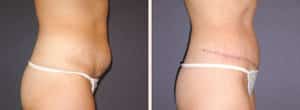Tummy Tuck (Abdominoplasty)
- Aging, weight changes, and pregnancy may cause the skin to lose its elasticity. This results in a “prune belly” appearance or a hanging apron-like fold of skin called a pannus. These conditions may not respond well to diet or exercise or liposuction only.
- With abdominoplasty, the abdominal wall muscles are tightened and excess fatty tissue and skin are removed to improve the body contour. The goal is a flatter abdomen without excess tissue.
- Liposuction is often used quite effectively in combination with abdominoplasty to contour the waist and the hips.
- Dr. Wigod considers age, weight and smoking habits when evaluating a candidate for this procedure. Patients should be close to an optimized weight before having the operation and be otherwise healthy.
- A full abdominoplasty addresses the upper and lower abdomen and has an incision around the umbilicus, while a mini abdominoplasty addresses the lower abdomen predominantly and has no umbilical incision.
- Full versus mini approach does not depend upon patient size but on anatomy.
- In the more common full abdominoplasty, a low incision curving between the hips is made. A second incision is made around the belly button (umbilicus).
- The skin is then separated from the abdominal wall and lifted up to the ribs and down to the pubis, exposing the abdominal muscle. Loose, stretched out muscles are tightened together vertically with sutures like an internal corset.
- Excess skin and fat are then removed. The skin is next stretched down over the abdomen, the mons is elevated, and the incisions are then sutured together.
- Finally, a new hole for the umbilicus is made and it is sutured into place. Drains are inserted to eliminate fluid buildup and a binder may be applied to the abdomen.
- Your skin will be closed by a combination of absorbable and non-absorbable sutures. Your visible sutures will be clipped at 1-2 weeks post-op. While every effort is made to minimize it, scarring should be expected and silicone gel scar treatments are advised for optimal results.
- You will have a rubber tube, called a drain, exiting from below one side of your incision. It allows closed removal of drainage from the wound and to decrease pain. Drains may be removed from one to two weeks after the operation.
- The drains should be emptied every 8 hours and the drainage tracked in milliliters (cc’s) as instructed by your nurse. You may shower with the drains in place. If a drain is accidentally removed, notify Dr. Wigod during the next business day.
- Recovery may be slowed by seroma (clear fluid collection between the skin and abdominal wall after drain removal). Other problems, such as delayed wound healing, bleeding, infection, or asymmetry, are less common, but may occur.
- Though the recovery period is longer than that of other cosmetic procedures, (waking only for three weeks then full activity at six weeks) abdominoplasty patients tend to be the most satisfied of any cosmetic surgery patients.
To schedule a consultation or for more Tummy Tuck (Abdominoplasty) information, please visit our contact page or call our office at (208) 377-9515.
